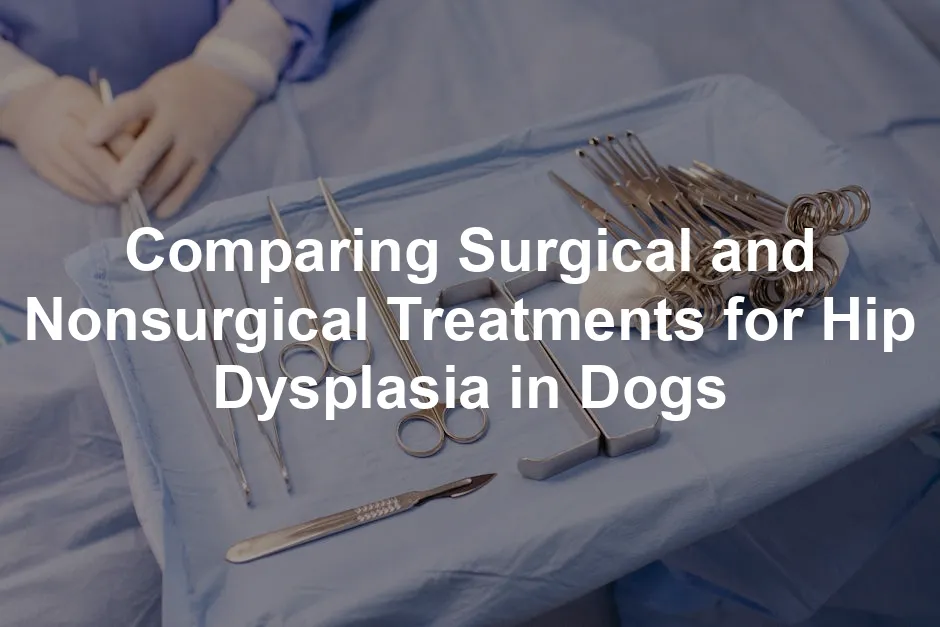Introduction
Hip dysplasia in dogs is no laughing matter, even if we sometimes joke about our furry friends’ silly antics. If you think your dog’s “bunny hop” is just a quirky dance move, think again! It might be hip dysplasia saying hello. This common orthopedic condition occurs when a dog’s hip joint doesn’t fit together perfectly. The result? Pain, limping, and a whole lot of discomfort for your beloved pooch. Understanding hip dysplasia is crucial for dog owners. It not only affects the dog’s current quality of life but can also lead to more serious issues down the line, like osteoarthritis. Knowing the treatment options available can be a game changer for both you and your canine companion. Whether it’s opting for surgical interventions or sticking with nonsurgical treatments, the right choice can help improve your dog’s mobility and comfort. From medications to physical therapy, there are various nonsurgical options to alleviate symptoms. However, sometimes surgery becomes the best route. With multiple surgical procedures available, including total hip replacement and femoral head ostectomy, it’s vital to weigh the pros and cons of each. No one wants their furry friend to suffer, so let’s explore the ins and outs of both surgical and nonsurgical treatments, helping you make the best decision for your four-legged family member.
While you’re at it, consider investing in a PetSafe Healthy Pet Gravity Feeder. This handy feeder ensures your furry friend gets the right portion sizes without you having to measure every meal. Less stress for you and more convenience for your pup!
Summary
Hip dysplasia (HD) is an orthopedic condition that affects many dogs, especially larger breeds. It results from an improper fit of the hip joint, leading to joint laxity, inflammation, and potential arthritis. Understanding the condition’s causes, symptoms, and treatment options is essential for pet owners. Nonsurgical treatments focus on managing symptoms and improving mobility. These can include medical management, weight optimization, and physical therapy. Medications like NSAIDs can help alleviate pain, while physical therapy may enhance mobility. However, these methods may not completely halt the progression of the disease. On the other hand, surgical options like total hip replacement (THR), femoral head ostectomy (FHO), and triple pelvic osteotomy (TPO) aim to improve joint function significantly. Each surgical option has its benefits and risks, with varying recovery times. THR, for instance, is considered the gold standard but requires careful consideration of the dog’s age and overall health. With various options available, how do you decide what’s best for your furry friend? It’s a tough call, but knowing the treatment landscape can empower you to make informed choices. Your vet can guide you through the decision-making process, ensuring your pup gets the care they deserve.For those looking to improve their dog’s mobility, consider adding Zesty Paws Mobility Bites to their diet. These tasty treats are loaded with ingredients that support joint health, making them a perfect complement to your dog’s care plan.
Symptoms of Hip Dysplasia
Hip dysplasia can be tricky to spot. Many dogs wear a brave face, but it’s essential to know the signs. Here are some common symptoms:- Limping: A telltale sign that something’s amiss. Dogs may limp, especially after exercise.
- Reluctance to Jump: If your pup suddenly avoids jumping or climbing stairs, it’s a red flag.
- Changes in Activity Levels: Is your dog less playful? A preference for lounging over romping around could signal discomfort.
- Painful Postures: Dogs might sit or lie down awkwardly to avoid putting weight on their affected hips.
If you want to keep your dog entertained while they recover, consider the Outward Hound Hide-A-Squirrel Puzzle Toy. This interactive toy keeps your pup engaged and mentally stimulated, which is just what they need during recovery!
Nonsurgical Treatment Options
Conservative Management
Weight Management and Nutrition
Maintaining a healthy weight is crucial. Extra pounds can add unnecessary stress to your dog’s joints. Think of it this way: less weight means less strain. A balanced diet helps to keep that waistline trim. Consult your vet for tailored dietary advice.Speaking of nutrition, consider feeding your pup Blue Buffalo Life Protection Formula Dog Food. It’s packed with quality ingredients that support your dog’s overall health and well-being!
Medications
Nonsteroidal anti-inflammatory drugs (NSAIDs) are commonly prescribed to manage pain and inflammation. These can provide much-needed relief. Just remember to follow your vet’s guidance on usage. Overdoing it can lead to side effects!Physical Therapy and Rehabilitation
Physical therapy can work wonders! Techniques like hydrotherapy are particularly beneficial. Swimming allows dogs to exercise without stressing their joints. Additionally, specific exercises can help improve mobility and strength. Regular sessions can make a significant difference in your dog’s comfort and activity levels.If you’re looking for a way to aid your dog’s physical therapy, consider the Dog Training Clicker. It’s a great tool to reinforce good behavior during training sessions!
Complementary Therapies
Complementary therapies can be great adjuncts to traditional treatments. Options like acupuncture and massage therapy help ease pain and improve mobility. Joint supplements, containing ingredients like glucosamine and omega-3 fatty acids, can also support joint health. It’s essential to note that these therapies are focused on symptom management rather than providing a cure. They aim to make your furry friend more comfortable while allowing them to enjoy life to the fullest.
Surgical Treatment Options
Overview of Surgical Interventions
Surgery is often considered when nonsurgical treatments no longer suffice. Severe cases of hip dysplasia often warrant surgical intervention. The severity of the condition and your dog’s overall health will dictate the best timing for surgery. If your dog struggles with mobility and pain, it may be time to consult your veterinarian about surgical options. Total hip replacement (THR) is often the go-to for severe cases. This procedure replaces the damaged joint with an artificial one, aiming to restore function and eliminate pain. Other options include femoral head ostectomy (FHO) and pelvic osteotomies, which can help in specific cases. Understanding when to pursue surgery is key to improving your pet’s quality of life. Surgical interventions can lead to significant improvements in mobility and pain management, making them a valuable option when needed. Your vet will guide you through the decision-making process, ensuring the best outcome for your four-legged friend.And don’t forget to prepare your home for your dog’s recovery with a PetFusion Ultimate Dog Bed. It provides a supportive and comfortable spot for your dog to rest while they heal!
Types of Surgical Procedures
Total Hip Replacement (THR)
– What it Involves: Total hip replacement is the gold standard for severe hip dysplasia. The surgery involves removing the damaged joint and replacing it with an artificial one made of metal and high-grade plastic. The procedure includes three key components: an acetabular implant, a femoral stem, and a femoral head. This new arrangement allows for smooth movement and pain-free function. – Indications: THR is typically recommended for dogs with significant pain and mobility issues where conservative treatments have failed. It’s suitable for dogs of various sizes, as long as they are skeletally mature, usually around 9-12 months old. – Outcomes and Risks: The recovery time is generally 12-16 weeks, with most dogs walking on the new joint soon after surgery. However, there are risks involved, including infection, implant failure, and potential femoral fractures. Nevertheless, most complications can be managed effectively, leading to improved mobility and quality of life.
Femoral Head Ostectomy (FHO)
– What it Involves: FHO is a salvage procedure that involves removing the femoral head, the ball portion of the hip joint. This turns the hip joint into a “pseudo-joint,” relying on surrounding muscles and soft tissues for support. – Indications: This procedure is often considered for dogs that are not candidates for THR, especially smaller breeds or those with severe joint damage. FHO can be done at any age, making it versatile. – Outcomes and Risks: While FHO can reduce pain and improve mobility, it may not restore full function. Rehabilitation is crucial for the best outcomes and may take 12-16 weeks. Risks include persistent lameness, reduced range of motion, or complications from surgery itself.Triple or Double Pelvic Osteotomy (TPO/DPO)
– What it Involves: TPO and DPO are surgical techniques aimed at improving joint stability. They involve cutting the pelvic bones and repositioning them to better cover the femoral head. TPO requires three cuts, while DPO simplifies the process by using two. – Indications: These procedures are ideal for young dogs, typically between 6 to 10 months old, who do not yet show signs of arthritis. The goal is to prevent the progression of hip dysplasia by stabilizing the joint. – Outcomes and Risks: Following surgery, many dogs experience a significant reduction in pain and improved mobility. Recovery usually takes about 8 weeks with limited activity. Risks include infection, issues with bone healing, and the potential for returning to previous levels of pain if arthritis develops.New Innovations in Surgery
Emerging techniques are changing the landscape of hip dysplasia treatments. One notable innovation is the use of personalized titanium implants, specifically designed for individual dogs. These implants aim to enhance joint stability and improve overall outcomes. As these techniques continue to develop, they offer hope for many dogs who suffer from this debilitating condition.And while we’re at it, don’t forget that your dog may need some additional support during recovery. A PetSafe Solvit PupSTEP Plus Pet Stairs can help them get up and down without straining their joints.

Comparing Outcomes
Effectiveness of Treatments
When it comes to treating hip dysplasia in dogs, the success rates of surgical and nonsurgical options can vary significantly. Surgical interventions, particularly Total Hip Replacement (THR), are often hailed as the gold standard. Studies show that THR can lead to an impressive 90-95% success rate, with dogs experiencing dramatic improvements in pain management and mobility. In contrast, nonsurgical treatments, while beneficial, may only offer moderate relief. Medications and physical therapy can help manage symptoms, but they often fail to address the underlying issues. Quality of life is a vital consideration. Surgical options typically provide a more permanent solution. Many dogs that undergo THR return to a pain-free, active lifestyle. It’s like giving them a second chance to chase squirrels and leap into the air after frisbees! On the other hand, nonsurgical methods, such as weight management and medications, can enhance comfort but may not halt the progression of the disease. So, while you might see a sparkle in your pup’s eye after a good hydrotherapy session, it’s essential to recognize that these treatments are more about managing symptoms than curing the condition. Pain management is another critical factor. With effective surgical procedures, most dogs experience significant pain reduction shortly after surgery. This can be a game changer for pets who have endured chronic discomfort. In contrast, nonsurgical treatments often rely on ongoing medication, which can come with side effects and escalating costs. Imagine trying to juggle constant vet visits and prescriptions— it can become a full-time job!And while you’re at it, consider investing in a Furminator Undercoat Deshedding Tool. This tool can help keep your dog’s coat healthy and reduce shedding, making grooming a breeze!

Risks and Considerations
Every treatment option comes with its own set of risks and considerations. Surgical procedures, while often effective, are not without complications. Risks associated with surgery include infection, anesthesia complications, and the possibility of implant failure. For instance, while THR has a high success rate, some dogs may experience issues like dislocation or fracture of the femur post-surgery. These risks can be daunting for pet owners. On the flip side, nonsurgical treatments also have their pitfalls. Prolonged reliance on medications like NSAIDs can lead to gastrointestinal issues and other side effects. Furthermore, these treatments do not prevent the inevitable progression of arthritis, leaving pets to cope with worsening symptoms over time. Patient-specific factors play a crucial role in determining the best treatment path. Age, breed, and overall health can influence the decision-making process. For example, younger dogs with mild dysplasia may benefit more from surgical interventions, while older dogs with other health issues might be better suited for nonsurgical options. Always consult your veterinarian to evaluate these individual factors and create a tailored treatment plan that ensures your furry friend gets the best care possible. It’s about finding the right balance for each unique pup!Conclusion
Understanding the various treatment options for hip dysplasia is paramount for pet owners. Both surgical and nonsurgical interventions have their advantages and disadvantages. The right choice for your dog hinges on several individual factors, including age, health status, and lifestyle. Working closely with your veterinarian can help you navigate this complex decision-making process. Ultimately, the goal is to improve your dog’s quality of life. Whether through surgery or conservative management, the focus should always be on enhancing comfort and mobility. Remember, every dog is unique, and what works for one may not work for another. In the end, the commitment to improving the quality of life for dogs with hip dysplasia is what truly matters. Your furry companion deserves the best possible care to continue living life to the fullest. So, take the time to explore all available options, keep that tail wagging, and ensure your pup can enjoy those carefree days of chasing after their favorite toys!
FAQs
What breeds are most susceptible to hip dysplasia?
Hip dysplasia doesn’t discriminate! Certain breeds are more prone to this pesky condition. Larger dogs, like German Shepherds, Golden Retrievers, and Labrador Retrievers, often find themselves on the list. But don’t let the size fool you! Smaller breeds like Bulldogs and Basset Hounds can also be affected. Genetics plays a significant role here. If you’re considering a puppy, ask breeders about their screening practices. Remember, prevention begins before they even take their first leap!
How do I know if my dog needs surgery?
Recognizing the signs your dog may need surgery can be tricky. If your furry friend is limping, struggling to jump, or showing signs of pain during activity, it’s time to consult your vet. X-rays are essential for assessing the severity of hip dysplasia. If nonsurgical treatments like weight management and physical therapy haven’t worked, surgery could be the next step. A thorough evaluation will help determine if your pup qualifies for a surgical option. Don’t hesitate—your dog’s comfort is worth it!
What is the recovery time for surgical options?
Ah, the recovery phase! After surgery, your dog will need some time to heal. For Total Hip Replacement (THR), recovery generally takes around 12-16 weeks. Femoral Head Ostectomy (FHO) requires a similar timeline, but rehabilitation is crucial for optimizing outcomes. Expect to limit your pup’s activity during this period. They’ll need some TLC and restricted leash walks at first. Staying patient and following your vet’s post-operative instructions is vital for a successful comeback!
Are there any preventative measures for hip dysplasia?
While you can’t entirely prevent hip dysplasia, you can take steps to reduce the risk. Start with responsible breeding practices. If you’re getting a puppy, choose breeders who screen for hip dysplasia. Maintain a healthy diet and weight for your dog. Proper nutrition is key! Regular exercise can also help strengthen muscles around the joints, but avoid overexerting young pups. Additionally, consider joint supplements after consulting your vet. Prevention is a team effort!
How much do treatments typically cost?
The cost of treating hip dysplasia can vary widely. Nonsurgical management, like medications and physical therapy, can range from a few hundred to several thousand dollars over a dog’s lifetime. Surgical procedures? They come with their price tags too. Total Hip Replacement can set you back anywhere from $1,500 to $7,000, depending on various factors like location and the veterinarian’s expertise. Always discuss financial options with your vet. They can help you explore the best path for your dog and your wallet!
For more information on managing this condition, check out our guide on Understanding and Managing Canine Hip Dysplasia.
Please let us know what you think about our content by leaving a comment down below!
Thank you for reading till here 🙂
If you’re looking for supplements to assist with joint pain, explore our post on Best Supplements for Dogs with Joint Pain and Arthritis.
All images from Pexels





